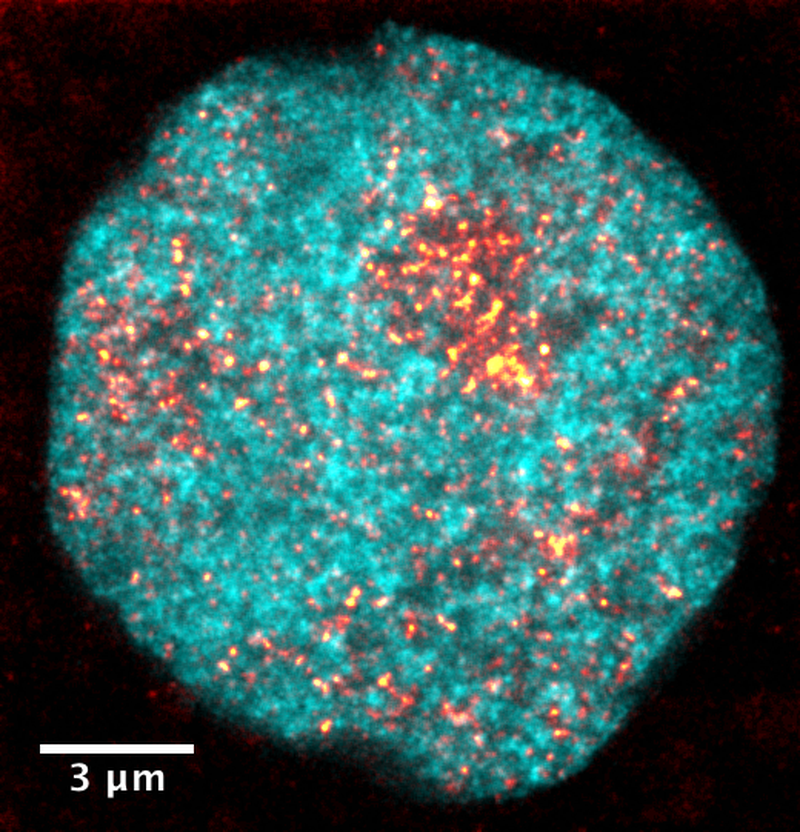Computational Architectures in the Cell Nucleus

The increasing need for data storage and ambitions for bio-compatible computing mark DNA computation as a critical future technology. DNA-based hardware, however, will be rooted in physical principles that fundamentally differ from electronic hardware. For example, information processing in dense suspensions of DNA will be severely limited by slow transport of information and occurs in a liquid, rather than in a static architecture. Also, like electronic computer chips in cellular devices, DNA hardware will only achieve its full potential once it can be ubiquitously embedded in biological cells and biotechnological devices.

Luckily, these challenges have already been overcome by the nucleus of the biological cell. The cell nucleus stores and manages access to more than 1 GB of DNA-encoded information. This genetic information is accessed in a massively parallel fashion, and processes that are based on this genetic information are fully integrated with cellular functions. Recent work, including our own, revealed that the targeted read-out of genetic information is closely connected to the three-dimensional (3D) organization of DNA in the cell nucleus: regions of the genome that are expressed become unfolded, regions that are repressed become compacted. Assuming that this adaptive 3D organization of DNA is central to effective information processing in the cell nucleus, we will
- explore the physical principles driving this adaptive 3D organization, using major gene regulatory transitions as biomimetic examples,
- investigate how this adaptive 3D organization can gate the access of regulatory factors to the genome, or, in other words, how 3D organization can gate the information flow into and out of different regions of the genome,
- exploit the above physical principles in the development of cell-embedded DNA computing modules that are switched on/off by 3D unfolding/compaction, and, potentially, the in vitro synthesis of DNA-based hardware.
Our techniques include molecular and cellular work with vertebrate cells (especially zebrafish), live and super-resolution microscopy, advanced image analysis, as well as computer simulations and (bio)physical modeling. Beyond our core team, we benefit from a strong environment of interdisciplinary collaborators as well as extensive animal, imaging, and computing infrastructures.
For further info, updates/social media, and opportunities/openings please visit hilbertlab.org
Lennart Hilbert
- Group: Hilbert
- Phone: +49 721 608-22887
- lennart hilbert ∂does-not-exist.kit edu
- Hermann-von-Helmholtz-Platz 1
76344 Eggenstein-Leopoldshafen
Publications
Gadzekpo, A.; Oprzeska-Zingrebe, E. A.; Kozlowska, M.; Hilbert, L.; Stoev, I. D.
2025. Advanced Functional Materials, Art.-Nr.: e19573. doi:10.1002/adfm.202519573
Hilbert, L.; Gadzekpo, A.; Vecchio, S. L.; Wellhäusser, M.; Tschurikow, X.; Prizak, R.; Becker, B.; Burghart, S.; Oprzeska-Zingrebe, E. A.
2025. Annals of the New York Academy of Sciences, 1552 (1), 12–28. doi:10.1111/nyas.15415
Barati Sedeh, A.
2025, August 7. Karlsruher Institut für Technologie (KIT). doi:10.5445/IR/1000183857
Dongre, S.; Hilbert, L.; Vastenhouw, N. L.
2025. Zygotic Genome Activation – Methods and Protocols. Ed.: M.C. Good, 89 – 117, Springer US. doi:10.1007/978-1-0716-4522-2_7
Prizak, R.; Gadzekpo, A.; Hilbert, L.
2025. Biophysical Journal, 124 (22), 3908–3922. doi:10.1016/j.bpj.2025.03.038
Hajiabadi, H.
2025, April 8. Karlsruher Institut für Technologie (KIT). doi:10.5445/IR/1000180867
Hilbert, L.
2024. BIOspektrum, 30 (1), 19–22. doi:10.1007/s12268-024-2090-4
Dai, S.; Kobitski, A.; Barati Sedeh, A.; Eroğlu-Kayıkçı, S.; Hilbert, L.; Nienhaus, G. U.
2024. ACS Photonics, 11 (1), 310–320. doi:10.1021/acsphotonics.3c01558
Friederich, N.; Yamachui Sitcheu, A. J.; Neumann, O.; Mikut, R.; Hilbert, L.
2024, March 12. AI and biology (2024), Heidelberg, Germany, March 12–15, 2024
Kumpost, V.
2024, March 12. Karlsruher Institut für Technologie (KIT). doi:10.5445/IR/1000169163
Hajiabadi, H.; Gerking, C.; Hilbert, L.; Koziolek, A.
2024. Journal of Systems and Software, 211, Article no: 111986. doi:10.1016/j.jss.2024.111986
Sedeh, A. B.; Kobitski, A.; Dai, S.; Eroğlu-Kayıkçı, S.; Nienhaus, K.; Hilbert, L.; Nienhaus, G. U.
2023. Optics Letters, 48 (21), 5791–5794. doi:10.1364/OL.502001
Friederich, N.; Yamachui Sitcheu, A. J.; Neumann, O.; Eroglu-Kayıkçı, S.; Prizak, R.; Hilbert, L.; Mikut, R.
2023. Proceedings-33. Workshop Computational Intelligence: Berlin, 23.-24. November 2023, 31–51, KIT Scientific Publishing. doi:10.48550/arXiv.2310.04461
Wernet, V.; Kriegler, M.; Kumpost, V.; Mikut, R.; Hilbert, L.; Fischer, R.
2023. eLife, 12, Art.-Nr.: e83310. doi:10.7554/eLife.83310
Tschurikow, X.; Gadzekpo, A.; Tran, M. P.; Chatterjee, R.; Sobucki, M.; Zaburdaev, V.; Göpfrich, K.; Hilbert, L.
2023. Nano Letters, 23 (17), 7815–7824. doi:10.1021/acs.nanolett.3c01301
Kumpost, V.; Hilbert, L.; Mikut, R.
2023. Journal of The Royal Society Interface, 20 (198), Art.-Nr.: 20220781. doi:10.1098/rsif.2022.0781
Hajiabadi, H.; Hilbert, L.; Koziolek, A.
2022. 2022 48th Euromicro Conference on Software Engineering and Advanced Applications (SEAA) : Aug. 31th – Sept. 2nd, 2022, ExpoMeloneras, Maspalomas, Gran Canaria, Spain, 5–12, Institute of Electrical and Electronics Engineers (IEEE). doi:10.1109/SEAA56994.2022.00011
Tran, M. P.; Chatterjee, R.; Dreher, Y.; Fichtler, J.; Jahnke, K.; Hilbert, L.; Zaburdaev, V.; Göpfrich, K.
2023. Small, 19 (13), Art.-Nr.: 2202711. doi:10.1002/smll.202202711
Hajiabadi, H.; Mamontova, I.; Prizak, R.; Pancholi, A.; Koziolek, A.; Hilbert, L.
2022. (K. E. Nelson, Ed.) PNAS Nexus, 1 (3), 1–12. doi:10.1093/pnasnexus/pgac065
Hilbert, L.; Sato, Y.; Kuznetsova, K.; Bianucci, T.; Kimura, H.; Jülicher, F.; Honigmann, A.; Zaburdaev, V.; Vastenhouw, N. L.
2021. Nature Communications, 12 (1), 4240. doi:10.1038/s41467-021-24517-7
Pancholi, A.; Klingberg, T.; Zhang, W.; Prizak, R.; Mamontova, I.; Noa, A.; Sobucki, M.; Kobitski, A. Y.; Nienhaus, G. U.; Zaburdaev, V.; Hilbert, L.
2021. Molecular Systems Biology, 17 (9), Art.Nr. e10272. doi:10.15252/msb.202110272
Kumpošt, V.; Vallone, D.; Gondi, S. B.; Foulkes, N. S.; Mikut, R.; Hilbert, L.
2021. Scientific reports, 11 (1), Art.-Nr.: 14497. doi:10.1038/s41598-021-93913-2
Noa, A.; Kuan, H.-S.; Aschmann, V.; Zaburdaev, V.; Hilbert, L.
2021. PLoS Computational Biology, 17 (5), e1008974. doi:10.1371/journal.pcbi.1008974
Hilbert, L.; Sato, Y.; Kuznetsova, K.; Bianucci, T.; Kimura, H.; Jülicher, F.; Honigmann, A.; Zaburdaev, V.; Vastenhouw, N. L.
2021. Nature Communications, 12 (1), Article no: 1360. doi:10.1038/s41467-021-21589-3
Sato, Y.; Hilbert, L.; Oda, H.; Wan, Y.; Heddleston, J. M.; Chew, T.-L.; Zaburdaev, V.; Keller, P.; Lionnet, T.; Vastenhouw, N.; Kimura, H.
2019. Development <Cambridge>, 146 (19), Article: dev179127. doi:10.1242/dev.179127
Zhang, W.; Noa, A.; Nienhaus, K.; Hilbert, L.; Nienhaus, G. U.
2019. Journal of physics / D, 52 (41), Art. Nr.: 414001. doi:10.1088/1361-6463/ab3200
Balassy, Z.; Lauzon, A.-M.; Hilbert, L.
2019. Proceedings of the National Academy of Sciences of the United States of America, 116 (35), 17336–17344. doi:10.1073/pnas.1904164116
